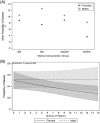Association between walnut consumption and diabetes risk in NHANES
- PMID: 29927053
- PMCID: PMC6220814
- DOI: 10.1002/dmrr.3031
Association between walnut consumption and diabetes risk in NHANES
Abstract
Background: Dietary interventions and cohort studies relating tree nut consumption to blood glucose levels suggest a possible effect of walnuts.
Objective: To examine the associations between walnut consumption and diabetes risk using data from the National Health and Nutrition Examination Survey.
Methods: National Health and Nutrition Examination Survey data on adults conducting 24-hour dietary recall was pooled across the years 1999 through 2014. Diabetes status or risk was based on self-report, medication use, fasting plasma glucose levels, and haemoglobin A1c (HbA1c ) levels. Individuals were characterized based on reported consumption of walnuts, mixed-nuts, or no nuts.
Results: After adjustment for covariates, walnut consumers showed lower risk for diabetes compared with non-nut consumers based on self-report (odds ratio of 0.47, 95% confidence interval [CI] 0.31-0.72) as well as fasting blood glucose (relative risk ratio 0.32, CI 0.17-0.58) and HbA1c (relative risk ratio 0.51, CI 0.27-0.99). For each standard deviation of increase in walnut intake, prevalence of diabetes dropped 47%. The gender by walnut interaction suggests that the effect may be more potent among women than men (dose response P = .061).
Conclusions: Both among individuals with known diabetes and those diagnosed based on elevated diabetes blood markers, the prevalence of individuals with diabetes was significantly lower among the walnut consumers. A possible gender-specific effect invites further attention.
Keywords: NHANES; diabetes mellitus; epidemiology; haemoglobin A1c; nut consumption; plasma glucose.
© 2018 The Authors. Diabetes/Metabolism Research and Reviews Published by John Wiley & Sons Ltd.
Figures
References
-
- Kalgaonkar S, Almario RU, Gurusinghe D, et al. Differential effects of walnuts vs almonds on improving metabolic and endocrine parameters in PCOS. Eur J Clin Nutr. 2011;65(3):386‐393. - PubMed
-
- Mukuddem‐Peterson J, Stonehouse Oosthuizen W, Jerling JC, Hanekom SM, White Z. Effects of a high walnut and high cashew nut diet on selected markers of the metabolic syndrome: a controlled feeding trial. Br J Nutr. 2007;97(6):1144‐1153. - PubMed
Publication types
MeSH terms
LinkOut - more resources
Full Text Sources
Other Literature Sources
Medical
Molecular Biology Databases
Miscellaneous



